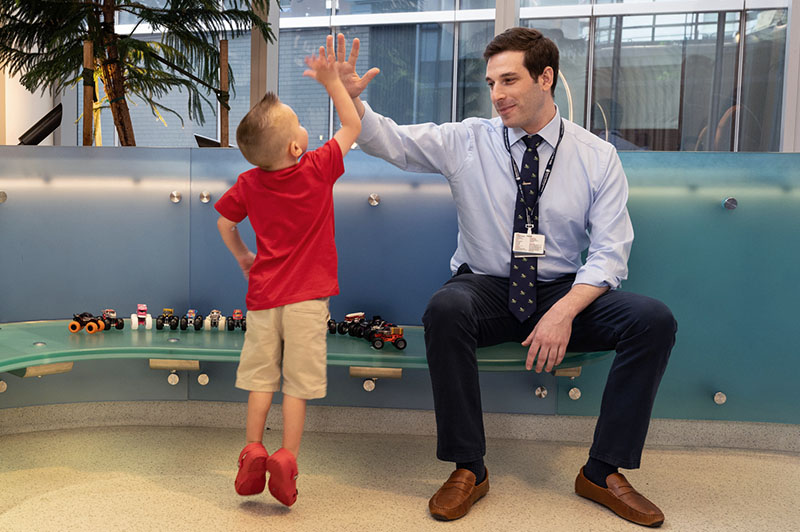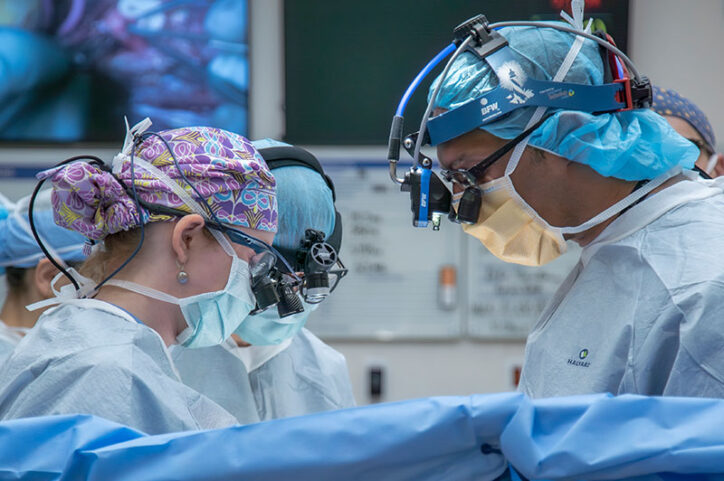
Boston Children's Hospital Cardiac surgeon Set overriding goals for each patient: If possible, Congenital Heart Disease (CHD) — Preserving natural heart tissue, rather than replacing it, often leads to a more rapid and complete recovery and longer-lasting heart function.
But in some cases, a patient's valve tissue cannot be repaired, and a bioprosthetic or mechanical replacement is the only option — that is, until the surgical team installed a new valve in May. Sitaram Emani, MDHe and his colleagues performed a partial heart transplant, using a donor aortic valve, on a 4-year-old boy. “I think this opens the door to treating a disease for which there is no ideal solution,” Emani says.
The patient, Jack Mangan, is “doing very well, better than he's ever been,” Emani said. The partial heart transplant is the first of its kind in New England, and judging by its success, likely the first at Boston Children's Hospital.
“Every patient needs to be examined individually.” Christopher Baird, MDa cardiac surgeon, Congenital Heart Valve Program“We always consider repairing or reconstructing the diseased valve first, but some patients need a tissue or mechanical valve replacement. We can do that with several procedures, including the Ross procedure or partial heart transplant, both of which replace the diseased valve with growing healthy valve tissue. It all comes down to what is the best option for the patient.”
Running out of treatment options
Jack is Aortic stenosisTwo Fetal Heart Intervention It prevented him from developing to his potential. Hypoplastic Left Heart Syndrome after that Surgical valve repair During the first year of life, he was left with aortic valve disease. “This is the reality of aortic valve surgery in infants and young children,” says one of his cardiologists. Matan Setton, MD“Even with perfect operation, there is a limit to its lifespan and durability.”
Dr. Emani tried to remove some of the tissue to make the aortic valve larger and easier to open, but the narrowing remained. The left ventricle must continue to work harder to pump blood to the body. Given that Jack had already had several surgeries and that scarring of the heart muscle had increased filling pressure in the left ventricle, Jack's care team determined that he needed a new aortic valve.
The team tentatively considered the Ross procedure, a final treatment option that would move the patient's pulmonary valve into place of the diseased aortic valve that had been removed. The new aortic valve would grow with the child, but the downside for some families is that the donor pulmonary valve would eventually have to be replaced.
Knowing that Jack's parents, Amy and Chris, wanted to avoid any future surgeries as much as possible, the care team floated the idea of a partial heart transplant. They advised that while early results suggest a partial heart transplant appears to be effective and safe, it is a new treatment. There is still a chance of complications, no matter how small, that could necessitate further surgery. “Still, this seemed like the most durable option,” Amy says. “We said, 'Let's give it a go. Let's work on this together as a team.' Now, Jack's heart is the healthiest it's ever been, and we are so grateful.”


A healthy aortic valve is provided by a heart donor
In a partial heart transplant, a diseased valve is replaced with a healthy valve from a donor. Cardiac surgery teams established protocols for partial heart transplants eight years ago, but didn't have an ideal patient until Jack. Duke University Hospital performed the world's first partial transplant in 2022, and several other heart centers have since followed suit.
Jack and his parents, who live in New Jersey, traveled to Boston as soon as a compatible donor was found. Benderson Family Heart Center — Cardiac surgeon, Cardiologist,nurse, Cardiovascular 3D Modeling and Simulation Teamand Cardiac Imaging The experts were prepared for that moment.
“The donor's heart muscle wasn't functioning well, so we weren't going to use it,” Emani recalls, “but the valve was working fine.” Working through the night and into the next day, Emani and his surgical colleagues removed the aortic valve from the donor's heart and placed it in the place vacated by Jack's own valve. They then connected Jack's coronary arteries to the new aorta.
“This was a unique opportunity to take advantage of the gift from the donor,” Emani said. The partial transplant appears to be the first in a patient who is not seriously ill, but rather is undertaken as an option for other treatments, he said.
Reduce medication and observe tissue growth
Patients who receive a new heart will need to take some immunosuppressant medication for the rest of their lives, but those who receive a partial heart transplant should only need to take smaller doses of immunosuppressant medication for a few months after surgery.
Jack is currently on enough medication to keep him from rejecting the new aortic valve, but his care team's goal is to gradually taper him off of it — an approach they're confident in, he says, because outside studies and catheter biopsies they've performed on patients' transplanted hearts have shown that the valves functioned normally even when the immune system was not sufficiently suppressed and the body was rejecting the new heart. Tajinder (TP) Singh, MD, M.S.A cardiologist who heads Jack's recovery care team.
Just as important, the researchers hope that the new aortic valve will grow with Jack, who is part of a clinical trial that will test the valve's growth over the next few years. (Data from the first operation at Duke showed that the replacement valve and arteries grew with the patient, who was a newborn at the time of the procedure.) “The idea is that if it's living tissue, the annulus should grow with the child,” Singh says.


Hope for Jack and those in need of new valves
Emani and his cardiologists believe partial heart transplants could be a viable option for patients whose valves are beyond repair. “This is something that has the potential to last for many years, if not more than a decade,” Seton says. And the procedure need not be limited to the aortic valve; the cardiac surgery team is currently looking into the possibility of replacing the diseased mitral valve with a healthy one from a donor.
Providing evidence for new standards
Dr. Sitaram Emani of Boston Children's Hospital, other cardiac surgeons, and the president of New England Donor Services argue that heart valves donated for partial heart transplants should be treated as organs, not tissue, and that the procedure can meet the same clinical and ethical standards that apply to organ transplants.
Read their opinion in the American Journal of Transplantation.
“The biggest weakness of cardiac surgery is the repair material,” Emani says. “You have to find the right material to repair a valve or a pulmonary artery, and it doesn't always work because you use dead or synthetic tissue. This surgery uses living tissue, which is a huge advantage. And because the rest of the patient's heart tissue is still functioning, a partial transplant is more ideal than a full transplant. Ideally, you want something that grows over time and you just want to replace the dysfunctional part.”
Jack is already showing signs of recovery: The transplanted aortic valve is functioning perfectly and he has shown no signs of rejecting the donor tissue, Seton and Singh say.
“He's such a great kid and so is his family,” Emani said. “We're all so happy that he's a pioneer in this field. He's a pioneer, so I was excited to be a part of it.”
Click here for details Congenital Heart Valve Program or Refer a patient.

